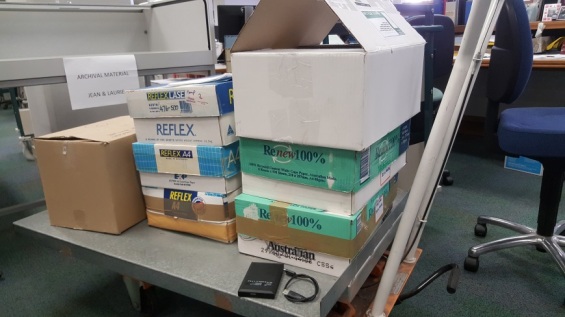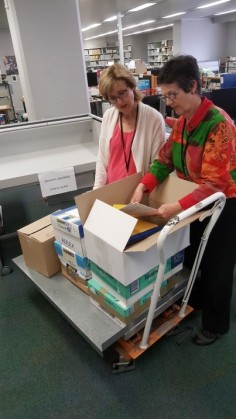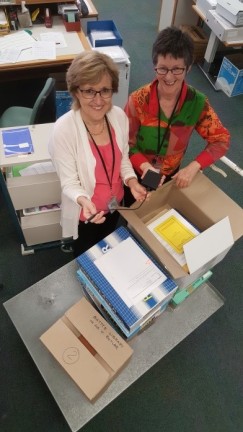From digital illustration to watercolor painting and screen-printing, three very different styles of illustration highlight the diversity and originality of picture books published this year.
In a series of exhibitions, The Story Place Gallery will showcase original artwork by Western Australian illustrators from the picture books 1,2 , Pirate Stew, (Five Mile Press 2017), One Thousand Trees and Colour Me (Fremantle Press 2017).

7, 8, he took the bait © Kylie Howarth 2017
In 1,2 , Pirate Stew, Kylie Howarth has used a digital Illustration process to merge her drawings created using water soluble pencils, with background textures painted by her two adventurous children Beau and Jack. Kylie Howarth’s playful illustrations of gentle colours, together with her entertaining rhyming verse, take readers on an imaginative adventure all about the joys of playing in a cardboard box. Illustrations from 1,2, Pirate Stew are on display from 26 May – 22 June.

Among © Kyle Hughes-Odgers 2017
Kyle Hughes-Odgers’ distinctive illustrations blend geometric shapes, patterns and forms. In his watercolour illustrations for One Thousand Trees, he uses translucent colours and a restricted colour palette to explore the relationship between humankind and the environment. Shades of green browns and grey blues emphasise contrasts between urban and natural scenes. Kyle Hughes-Odgers places the words of the story within his illustrations to accentuate meaning. One Thousand Trees is on display from 24 June to 23 July.

If I was red © Moira Court
Moira Court’s bold illustration for the book Colour Me (written by Ezekiel Kwaymullina) were created using a woodcut and screen printing technique. Each final illustration is made from layers of silk screen prints created using hand cut paper stencils and transparent ink. Each screen print was then layered with a patchy, textural woodcut or linoleum print. Colours were printed one at a time to achieve a transparent effect. The story celebrates the power of each individual colour, as well as the power of their combination. Colour Me is on display from 26 July – 16 August.
Each exhibition in this series is curated especially for children and is accompanied by a story sharing area, self-directed activity, and discussion prompters for families.
- The State Library of Western Australia is a wheel chair accessible venue
- The exhibitions are located in the The Story Place, a vibrant and accessible area with plenty for children and families to do. Located on the mezzanine floor of the State Library The Story Place hosts regular activities including Baby Rhyme Time, Story Time and Activity Time. For more information go to www.slwa.wa.gov.au
















 Unpublished spread 14 for pages 32 – 33
Unpublished spread 14 for pages 32 – 33










 School magazines provide a fascinating glimpse into the past.
School magazines provide a fascinating glimpse into the past.







 At about this stage, we peered across at the trolleys, neatly stacked with archive boxes full of paper, and started wondering if (or how much) of what was on the trolleys was replicated on the hard drive. How would we check this? Do we check this? If we do find duplicates, which one do we keep? Maybe we should keep both? Challenge 3 was now upon us – identifying and handling duplicates. In case we didn’t have enough to worry about, there’s a folder on the hard drive labelled ‘Archive’. Gulp. Sounds like more duplicates. Probably not an unfamiliar scenario for some of you dear readers?
At about this stage, we peered across at the trolleys, neatly stacked with archive boxes full of paper, and started wondering if (or how much) of what was on the trolleys was replicated on the hard drive. How would we check this? Do we check this? If we do find duplicates, which one do we keep? Maybe we should keep both? Challenge 3 was now upon us – identifying and handling duplicates. In case we didn’t have enough to worry about, there’s a folder on the hard drive labelled ‘Archive’. Gulp. Sounds like more duplicates. Probably not an unfamiliar scenario for some of you dear readers? Now, I’ve saved the best until last (for this post anyway – we’re not quite done with the whole process). Challenge 5 is around being able to read/open files. It didn’t take long for us to identify that there were a bunch of files that we do not have the software to open. Without the ability to open the files, how can we evaluate them? Maybe we shouldn’t worry too much, as that might be the role of the researcher? (The equivalent hardcopy ‘problem’ would be having a book written in French – I can’t read it, but you might be able to). What is the common ‘language’ in your family?
Now, I’ve saved the best until last (for this post anyway – we’re not quite done with the whole process). Challenge 5 is around being able to read/open files. It didn’t take long for us to identify that there were a bunch of files that we do not have the software to open. Without the ability to open the files, how can we evaluate them? Maybe we shouldn’t worry too much, as that might be the role of the researcher? (The equivalent hardcopy ‘problem’ would be having a book written in French – I can’t read it, but you might be able to). What is the common ‘language’ in your family?





